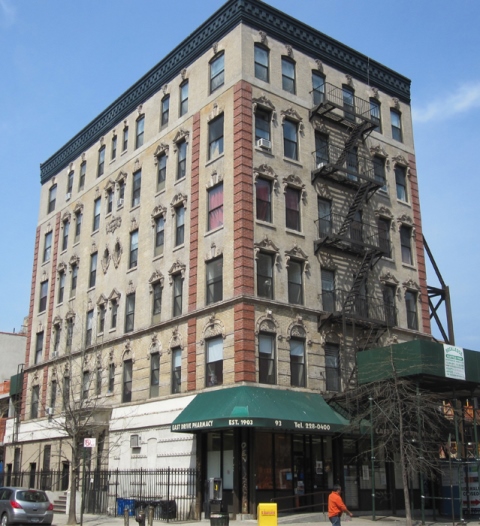Buildings With Buzzcuts

Have you ever noticed a rowhouse or tenement that’s almost handsome? Something … is … off. Oh! That’s what it is: Its top is shorn. Where a decorative cornice once hung, now there’s a blank — or worse, metal flashing. Why must perfectly decent architecture be diminished in this way?
Money, says Robert Perl, the president of Tower Brokerage on East 10th Street. Around the East Village, Perl owns a passel of residential buildings, many with commercial on the ground floor. He’s invested in a number of cornices, and believes it’s worthwhile, but he also knows the challenge and expense of upkeep.
“A lot in this neighborhood are made of tin. There’s some degree of rot. Unless you maintain them, there’s rust. When there’s rust, they basically become pigeon coops,” Perl said.
A cornice is both decorative and functional: like an umbrella, it directs water away from the building and helps prevent structural damage. And of course it lends “presence” and distinction, even interpreted in many different styles over the centuries.

Perl recalls spending about $30,000 in today’s dollars for the materials, labor and insurance needed to patch and paint the long cornice on his corner building at 262 E. 2nd Street a while back. “It’s not like it creates rent, it just keeps the beauty of the neighborhood,” he said.
In an effort to both save money on maintenance and avoid the literal “fallout” of decaying cornices, some property owners simply remove the crowns. They may be concerned about meeting the requirements of Local Law 11, which requires façade inspections every five years for buildings six stories and taller, to ensure their integrity and safety.
According to this New York Times article, preservationist Thom Bess is such a fan of the cornices of Harlem that he got them listed on the National Trust for Historic Preservation’s “11 Most Endangered” list of 1994.
“It’s great for owners to take pride in the facades of their buildings,” says Perl. “It does affect the atmosphere of the entire neighborhood. Hopefully they’ll take pride in maintaining the more traditional aspects of these buildings, because once it’s gone, they’re hard to recreate.”


8/13/2023; Hello, my name is Mary Steiner. I am organizing a group for Local Law 11 (FISP) reform. Pls email for more information.